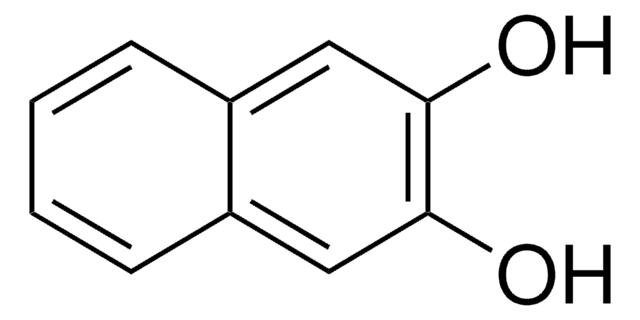70650
1,3-Dihydroxynaphthalene
for spectrophotometric det. of glucuronic acid according to Tollens, ≥97.0%
Synonym(s):
1,3-Naphthalenediol, Naphthoresorcinol
Sign Into View Organizational & Contract Pricing
All Photos(1)
About This Item
Linear Formula:
C10H6(OH)2
CAS Number:
Molecular Weight:
160.17
Beilstein:
2044002
EC Number:
MDL number:
UNSPSC Code:
12000000
PubChem Substance ID:
NACRES:
NA.21
Recommended Products
Quality Level
Assay
≥97.0% (HPLC)
≥97.0%
form
crystals
quality
for spectrophotometric det. of glucuronic acid according to Tollens
technique(s)
UV/Vis spectroscopy: suitable
mp
122-125 °C
123-125 °C (lit.)
SMILES string
Oc1cc(O)c2ccccc2c1
InChI
1S/C10H8O2/c11-8-5-7-3-1-2-4-9(7)10(12)6-8/h1-6,11-12H
InChI key
XOOMNEFVDUTJPP-UHFFFAOYSA-N
Looking for similar products? Visit Product Comparison Guide
Application
1,3-Dihydroxynaphthalene may be used as a background electrolyte (BGE) for the determination of carbohydrates by high-performance capillary electrophoresis (HPCE) method with indirect absorbance detection.
related product
Product No.
Description
Pricing
Signal Word
Warning
Hazard Statements
Precautionary Statements
Hazard Classifications
Muta. 2
Storage Class Code
11 - Combustible Solids
WGK
WGK 3
Flash Point(F)
Not applicable
Flash Point(C)
Not applicable
Personal Protective Equipment
dust mask type N95 (US), Eyeshields, Gloves
Choose from one of the most recent versions:
Already Own This Product?
Find documentation for the products that you have recently purchased in the Document Library.
Determination of carbohydrates by high-performance capillary electrophoresis with indirect absorbance detection.
Lee YH and Lin TI
Journal of Chromatography. B, Biomedical Sciences and Applications, 681(1), 87- 97 (1996)
Amy L Kieran et al.
Chemical communications (Cambridge, England), (14)(14), 1842-1844 (2005-03-30)
New macrocycles incorporating a porphyrin and a [small pi] electron-rich aromatic were prepared from a dynamic disulfide library. The outcome could be influenced by use of templates.
Wilson Terán et al.
The Journal of biological chemistry, 281(11), 7102-7109 (2006-01-13)
The RND family transporter TtgABC and its cognate repressor TtgR from Pseudomonas putida DOT-T1E were both shown to possess multidrug recognition properties. Structurally unrelated molecules such as chloramphenicol, butyl paraben, 1,3-dihydroxynaphthalene, and several flavonoids are substrates of TtgABC and activate
Hikoto Ohta et al.
Journal of forensic sciences, 49(3), 517-522 (2004-06-03)
The chemical compound 5-(4-nitrophenyl)-2,4-pentadien-1-al (NPPD), called "spy dust," was used in the Soviet Union as a shadowing pursuit, the act of following someone secretly, for investigating the activities of diplomatic personnel. It is also useful for counter-terrorism, and some criminal
Determination of glycolaldehyde in the presence of hydroxypyruvate and tartronate semialdehyde.
F E de Windt et al.
Analytical biochemistry, 106(2), 342-343 (1980-08-01)
Our team of scientists has experience in all areas of research including Life Science, Material Science, Chemical Synthesis, Chromatography, Analytical and many others.
Contact Technical Service









